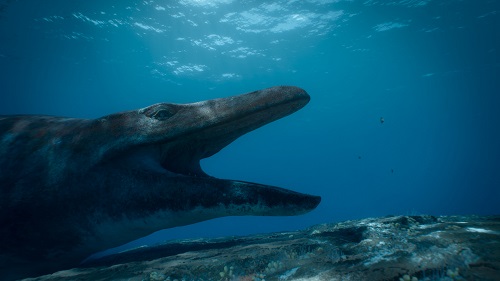Megalosaurus doesn’t get as much love as it deserves. It’s one of those B-list dinosaurs that hardly ever gets talked about. In fact, if Megalosaurus gets talked about at all, it’s usually in reference to the character Earl Sinclair on the amazing tv show Dinosaurs (1991-1994), who was a Megalosaurus and also awesome. But there’s much more to Magalosaurus than a tv show.
Today on Beyond Bones we’re going to list 5 facts about Megalosaurus that will prove that the great lizard is more important to the study of dinosaurs than many of its more famous cousins.
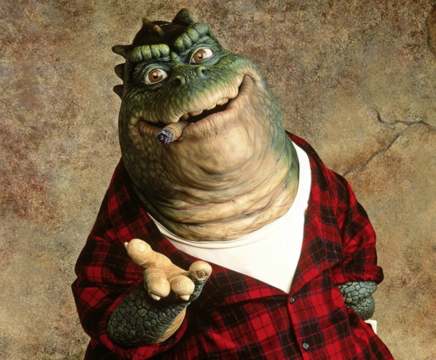
1. It was the first non-avian dinosaur genus to be scientifically described
People have been digging up fossilized remains of dinosaurs and other ancient creatures all over the world since the dawn of civilization, but up until the early 19th century, they usually attributed fossilized bones to mythological creatures or natural geological processes. Then in 1821 a particular set of fossils fell into the hands of pioneering paleontologist William Buckland. These fossils included a partial jawbone, several vertebrae, part of a hip, an arm bone and a leg bone belonging to a creature that would later be dubbed Megalosaurus.
At the time nobody knew what dinosaurs were, so when Buckland examined these remains he had no idea what animal they belonged to. All he knew was that the bones were old and that they were unlike anything he had ever seen before. He invited George Cuvier (commonly referred to as the father of paleontology) to examine the fossils. After looking at them, Cuvier declared that they belonged to a gigantic reptilian creature. Buckland dubbed his find Megalosaurus, meaning “great lizard”, referring to the animal’s enormous size. By his calculations, Megalosaurus was 40 feet long and over 9 feet tall. Modern estimates place the creature’s length at closer to 30 feet, still pretty impressive!
Buckland announced his discovery in 1824 during a meeting of the Geological Society of London, making Megalosaurus the first non-avian dinosaur ever to be scientifically described.
2. Its original scientific name was Scrotum humanum
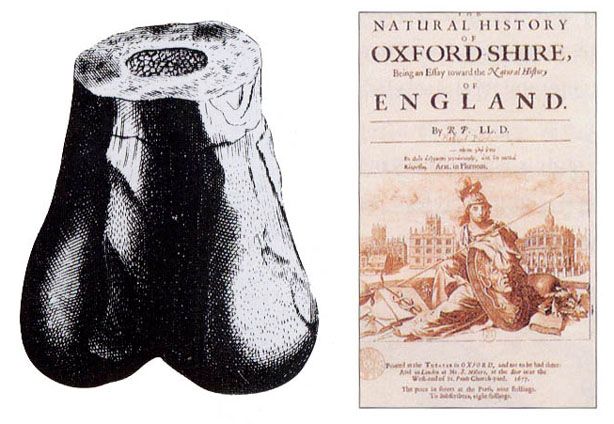
Long before Buckland, in 1676, an unusual bone fragment was recovered from a limestone quarry in Oxfordshire, England. It was a fragment of the lower end of a femur belonging to a massive animal. The fossil was examined by Robert Plot, professor of chemistry at Oxford University, who believed it belonged to a Roman war elephant.
Although Plot was completely wrong about what animal the bone belonged to, his illustration of the fossil, which was included in his Natural History of Oxfordshire published in 1676, was the first dinosaur fossil illustration ever to be published, which makes it pretty significant in the history of paleontology. He captioned the illustration “Scrotum humanum“, apparently because he thought the fossil resembled human testicles. So for all intents and purposes, “Scrotum humanum” was the official taxonomic classification of that bone and the creature it belonged to. Usually the first name to be applied to a species becomes its official name, even if the organism in question turns out to be quite different in appearance or relation to other animals than it’s discoverer envisioned it. Fortunately (or unfortunately, depending on your sense of humor) despite being first, Plot’s name was cast off in favor of Buckland’s name.
3. Paleontologists originally thought it walked on all fours
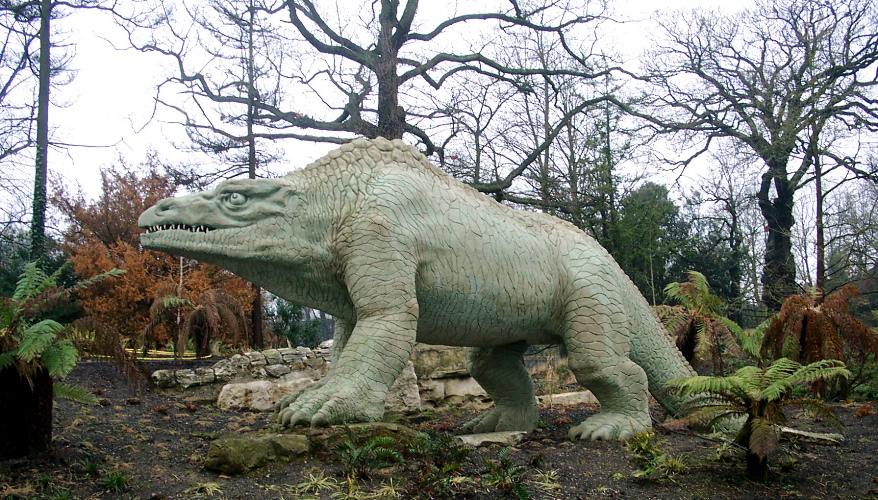
In the early-to-mid 19th century, most dinosaurs were believed to have been quadrupedal. Megalosaurus was no exception to this rule. Early reconstructions of the creature resemble the demonic dog creatures featured in Ghostbusters. It was not until later discoveries of obviously bipedal dinosaurs such a Compsognathus and Eustreptospondylus ,in 1859 and 1870 respectively, that paleontologists began to reexamine older finds such as Megalosaurus.
4.The man who named it had infamous eating habits
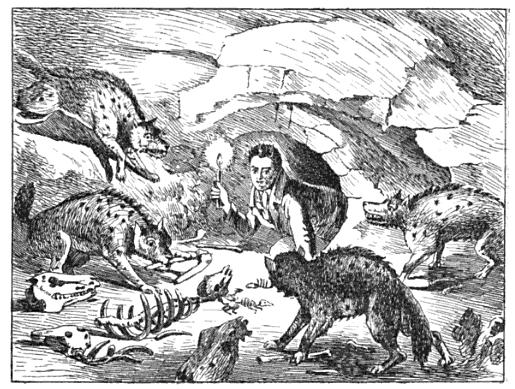
The geologist William Conybeare drew this cartoon of William Buckland sticking his head into a hyena den to honor Buckland’s ground breaking analysis of fossils found at Kirkdale cave. 1822. Source: Wikimedia Commons.
William Buckland was famous all over Europe for his achievements in interpreting the geologic history of the continent. But he had a couple eccentricities that sometimes overshadowed his achievements. One of them was his lecturing style. One famous incident recounted by one of his former pupils involves him running up to students sitting in the front row during a lecture and lunging a hyena skull in their faces while yelling “what controls the world?!”. When the terrified students failed to come up with a response, he replied “the stomach controls the world”. He was trying to make a statement about food chains, but the statement could equally be applied to Buckland’s other infamous eccentricity: his eating habits.
As a member of the Society for the Acclimatization of Animals, Buckland imported all sorts of exotic creatures to use in various studies. Many of these animals eventually ended up on his dinner plate. Apparently he was researching potential new sources of meat that could be imported to England (at least that was the excuse he gave).
He ate almost every animal you could think of, including panthers, hyenas, mice, various bugs and puppies. Yes, puppies…. Legend has it that at some point he was given access to a treasured locket containing the supposed mummified heart of King Louis XIV. The story goes that Buckland, unable to pass up an opportunity to expand his gastronomic horizons, quickly ate the walnut-sized mummy-heart.
5. Megalosaurus was named long before the name “dinosaur” was coined
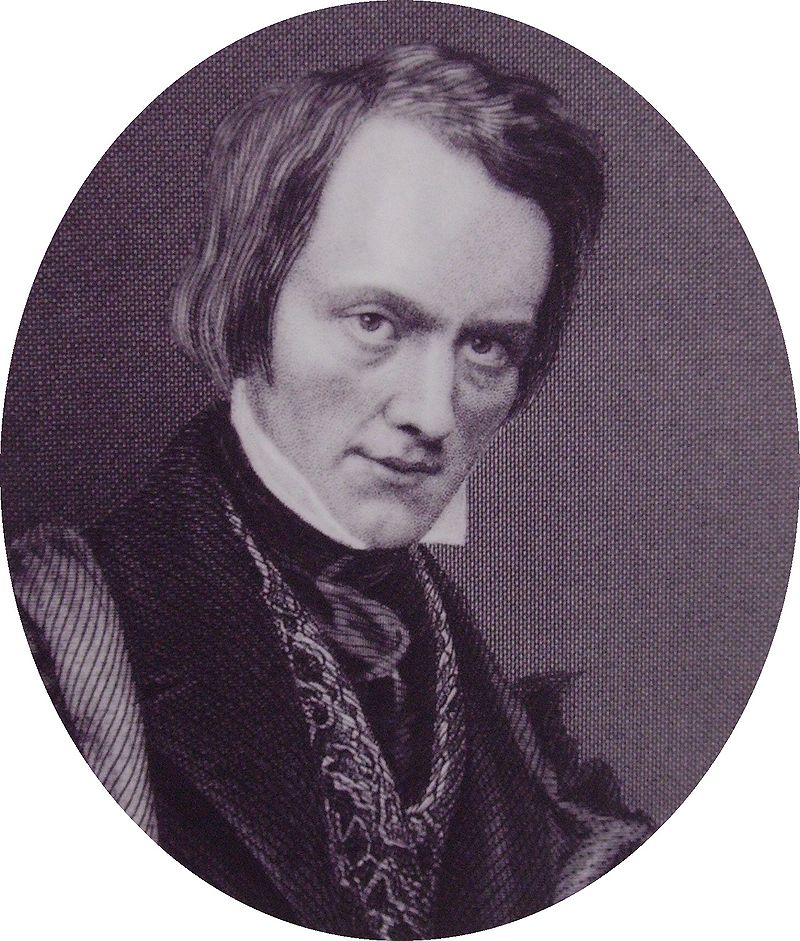
The word “Dinosaur” was coined in 1841 by paleontologist Sir Richard Owen. This was 17 years after Megalosaurus had been formally described. Two other dinosaur species, Iguanodon and Hylaeosaurus, also predate the actual creation of the taxon to which they belong. Upon recognizing several similarities in the skeletal structure of these creatures, Richard Owen decided they shared enough features to form a distinct taxonomic group, which he called Dinosauria or “terrible lizard”.
I hope you enjoyed this blog! Hopefully you learned to appreciate the mighty Megalosaurus a little more than you did before. If this article made you want to learn more about dinosaurs, you should think about visiting the Morian Hall of Paleontology at the Houston Museum of Natural Science. There’s tons to discover around every corner of our massive exhibit!






